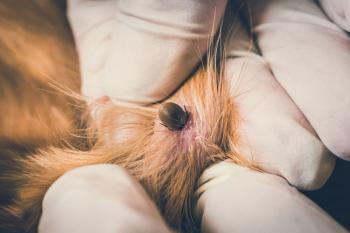
Why pets age and how can influence the process (Proceedings)
An animal's life can be divided into four stages; pediatric, adult, senior (middle age), and geriatric (senior / super senior). The senior / middle age years represents the transition period between the usually uneventful "healthy" adult years and the traditional "geriatric" age period where serious age related diseases are much more prevalent.
An animal's life can be divided into four stages; pediatric, adult, senior (middle age), and geriatric (senior / super senior). The senior / middle age years represents the transition period between the usually uneventful "healthy" adult years and the traditional "geriatric" age period where serious age related diseases are much more prevalent. This transition period signals the patient's initial decline in physical condition, organ function, sensory function, mental function and immune responses. An appropriate medical response would be taking a better history, performing an age-related physical examination, recommending routine diagnostic screening tests, advocating a premium senior diet, plus training the owners to actively look for age-related diseases. Although the exact time of each stage could be argued, everyone would agree that cats live longer than dogs; smaller breed dogs live longer than that larger breed dogs; and that each life stage would have a corresponding chronological difference. Human / Pet Age analogy charts (see below) reinforces this "time compression" concept and should be used to educate both hospital staff and clients. These relative age charts also emphasizes the concept of comparable "time compression" differences related to routine wellness testing intervals, chronic disease progression, and chronic drug monitoring intervals.
Aging is the sum of the deleterious effects of time upon the cellular function, microanatomy and physiology of each body system with each organ system aging at a different rate. These "biological aging" changes manifest in progressive deteriorations in physical condition, organ function, mental function, and immune response, but not necessarily correlating with the patient's actual "chronological age". "Chronological" aging in calendar-based and should be distinguished from "biologic" aging" the relative functional age of each of organ systems which is evidence-based. Because there is little correlation between biologic and chronological age, each animal must still be evaluated individually.
Aging is not a specific disease, but rather a complex process influenced by genetics, environment, stress and nutrition. These factors affect progressive irreversible degenerative changes of all body tissues. Aging in dogs and cats is associated with gradual and progressive deterioration in the delicate body systems that eventually results in decreased physiological functions. As the functional organ reserves are gradually lost, the long-term result is a physiological decline of the major organ systems leading to an altered response to stressors, infections and various drugs. At some stage in the progressive decline, all physiological reserves are exhausted ("tipping point") resulting in overt changes in either a diagnostic screening test, biochemical parameter, and/or the earliest onset of clinical symptoms.
Aging is a complex subject influenced by numerous interrelated causative factors. The current causes / theories, aging can be broken down into four general categories; 1. Accumulations of toxic substances or compounds within cells; 2. Cellular damage from ionizing irradiation, environmental pollutants, and more importantly, oxygen derived free-radical-mediated damage; 3. Immune mediated or immune compromised disease; and 4. Genetic factors. Combiner genetic factors are responsible for 30% – 35% of a dog's and cat's longevity. Unfortunately, there is nothing we can do to counteract the genetics of aging. Most of the current anti-aging research involves the limiting the production and preventing the cellular damage associated with oxygen derived free radicals. The "Free-Radical Theory of Aging" was first proposed by Denham Harmon in 1956. Now proven, the excessive free radicals associated with normal age-related metabolism and also produced during chronic inflammation have deleterious effects on cells, cell membranes, cell organelles, and cellular DNA.
As animals age, their basal metabolic rate (BMR) decreases. The consequences include weight gain if the there is not a corresponding decrease in caloric intake; less metabolic heat generated resulting in a "cold" patient; and decreased cell turnover in GI tract; and a decrease in metabolism of various drugs. The mitochondrial energy production in less efficient, resulting in excess oxygen derived free radical production. These free radicals damages cells, cellular organelles, cell membranes, and DNA. In addition, there is also an age-related decrease in the body's "natural" free radical scavenger systems. Both factors combined results in an absolute excess in free radicals often referred to as "oxidative stress". Age-related diseases where free radicals play a significant role in the pathogenesis include; CDS, arthritis, cataracts, liver disease, skin changes and some cancers.
Antioxidants are substances that "protect" against the effects of free radicals and are often referred to as "anti-aging" compounds in the media and product promotions. In dogs, anti-oxidants either in the diet or as supplements, decrease cellular damage from free radicals plus support the patient's immune function. However, since each group of anti-oxidants does not have the exact same mechanism of action, a complete anti-oxidant "package" is a far better strategy than a "pick and choose" method. Vitamins E, C & Zinc neutralize the damage from free radicals; Fatty acids DHA, EPA and SAMe protect the cell membranes form free radical damage; Lipoic Acid (can be toxic to cats) and L-carnitine limits the production of free radicals; and Carotenoids and Flavonoids inactivate the free radical acting as scavengers. To aid in supporting the canine patient' s immune function, Vitamin E helps with T cell activation, Lutein helps with B cell activation including vaccine recognition and beta carotene increases circulating antibodies and optimizes vaccine antigen recognition.
Unfortunately supplements are not regulated; therefore quality assurance issue is always an issue. In addition to quality and balanced age specific ingredients, plus increases in beneficial dietary fiber, most premium senior diets contain some a combination of anti-oxidants, referred to as an "anti-oxidant package". In my opinion, recommending a senior diet for all your "healthy" senior patients is an appropriate practice. Anti-oxidants containing "prescription" diets are also used as part of a multi-modal strategy in managing specific disease processes i.e.; CDS and arthritis in older dogs.
One cannot discuss slowing the aging process without mentioning the role of exercise in the overall well being of the older patient. In people the benefits of regular exercise are well documented. A regular scheduled exercise program should be our professional recommendation for every senior patient in our practice. In dogs, exercise will help minimize stiffness; maintain important muscle mass; will keep the joints limber; and aid in weight control. Older dogs with difficulty sleeping can benefit from a brisk 10 minute walk before bed time. In addition, several studies have shown the two 10 minute daily walks can increase a patient's mental attitude by increasing the oxygen flow to the brain plus increasing the brain serotonin levels. The only obvious contraindication to an exercise program would be an unstable joint or cardio-pulmonary compromise.
Newsletter
From exam room tips to practice management insights, get trusted veterinary news delivered straight to your inbox—subscribe to dvm360.




